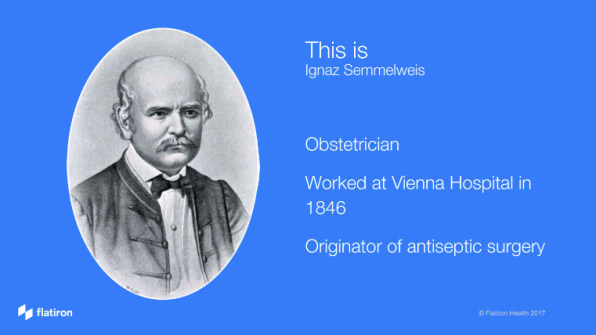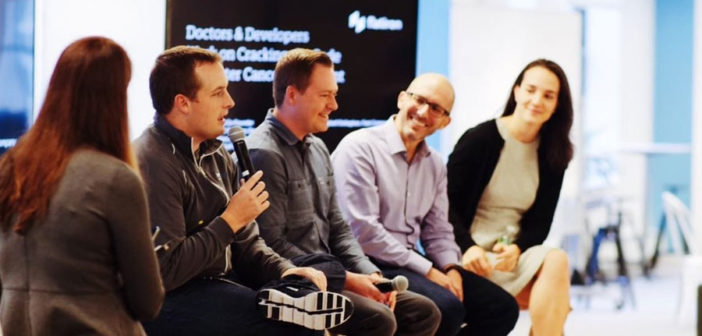No, it didn’t involve Steve Ballmer and Bill Gates dancing onstage. It happened 170 years ago in the maternity ward at a Vienna hospital.
Juicero. #Couragegate. New Coke. In this world of million-dollar keynotes, it’s not hard to think of product launches gone wrong, for whatever reason–an audience that felt betrayed or insulted, a poor choice of words, or simply bad design. They all pale in comparison to the Hungarian obstetrician Ignaz Semmelweis, whose life-saving product was ignored for decades because of the way he launched it.
In school, you probably learned that the discovery of germs in the 1860s led to the seemingly simple idea that sanitizing our tools and ourselves–especially our hands–can save lives. Lesser known is the fact that Ignaz Semmelweis was begging doctors to wash their hands decades before, and was completely ignored. Semmelweis’s story is tragic–and it’s an instructive example of how a bad launch strategy can doom even the best idea, as Flatiron Health‘s Rohit Parulkar explained at the Fast Company Innovation Festival last week.

Semmelweis worked in Vienna in the 1840s, and observed that mothers and babies who were seen by doctors rather than midwives were 10 times more likely to die in childbirth. He spent years studying why, and slowly realized that these doctors often came to the maternity ward after performing autopsies on cadavers. At the time, Parulkar explained, having blood on your coat was a “badge of honor,” and doctors would leave their hands and clothing dirty while they delivered newborns. After proving his idea through tests, he became obsessed with trying to get doctors to wash their hands before delivering babies. Yet it took 30 more years for doctors to start washing their hands–and when they did, it wasn’t because of Semmelweis, who ultimately went insane and died of an infection in an asylum. So what happened?
“Semmelweis was operating in a classic startup mode,” says Parulkar. “He had a great idea, he built a beta product, and then he validated it with customers. But he had a really terrible product launch strategy.” First, he attacked his customers–the doctors–by yelling at them about the patients they were killing. Second, he was a poor communicator, writing incoherently and refusing to publish. Third, he ignored his “credibility gaps,” or the things that made doctors less likely to trust him, including the fact that he was unlikeable and incredibly hard to work with. “Ultimately, it took 30 years to adopt one of the best ideas in medicine,” Parulkar concludes.
While Semmelweis may have been launching his idea 170 years ago, he fell victim to the same thing many startups do–today known as the “chasm,” or the point on the technology adoption cycle where early adopters have signed on, but the bigger market still isn’t convinced. It’s a common place for startups to fail, as Parulkar explains: “They fail because they can’t negotiate that path between having an idea and getting it adopted by a broader market.” In healthcare in particular, it’s known as the “quality chasm,” or the hurdle between research and actual practice. For instance, 97% of adult cancer patients in the U.S. aren’t involved in clinical trials, so their data doesn’t influence practice.
Parulkar is a data insights engineer at Flatiron Health, the five-year-old healthcare startup that brings together engineers and oncologists to build products that change cancer research and patient care. The company, which was recently valued at $1.2 billion and whose products now touch millions of cancer patients and doctors in the U.S., is designing tools that make it easier for doctors to collect and analyze data about cancer. The question of being able to turn “knowledge into practice” is a key one, which is why Semmelweis’s story is so important to them.

Take an interface Flatiron built for cancer clinics. As Parulkar explains, the goal was to create a tool that for a treatment program called the Oncology Care Model–“value-based care,” or the practice of rewarding the system when a patient gets better, rather than rewarding it when the patient gets more care. It’s a complex problem in the U.S., and Flatiron is building products that aim to enact that change. Because doctors tend to be competitive with their peers, the company decided to design a tool that would compare their performance to other doctors. It required translating hundreds of data points into a single dashboard that would give doctors a percentage for their relative performance. Yet in every case, their tool showed “0s.” After a long process of searching for a bug or some other mistake, they realized it was something very simple: The way each data point was documented tended to vary wildly from cancer clinic to cancer clinic, from physician to physician. Sometimes they weren’t recorded at all. “We had thought that because we had a great idea, and that it was so well defined, we could translate research directly into practice,” Parulkar says. “Probably sounds like someone else.”So they decided to focus on the practical problem holding up their great idea: on making it easier for clinics and doctors to actually record and access all that data. They also went back to talk to medical professionals about what they really needed to accurately document the data for each patient. “What they said was, while retrospective analyses of their performance is great, what they really wanted, and the most impactful thing, was to be able to access advanced research right at the point of care, when they’re making a treatment decision,” Parulkar says. Flatiron is now investing in software that lets doctors easily access research right when they’re working with a particular patient. It seems like a simple idea, but it demonstrates some of the problems with building successful products (which Semmelweis would have appreciated).
You can have all the data and science on your side, and a great idea, but if you don’t understand your audience and invest real time in talking to them about what they really need and how your data relates to those needs, they won’t use your tools.
–
This article first appeared in www.fastcodesign.com
Seeking to build and grow your brand using the force of consumer insight, strategic foresight, creative disruption and technology prowess? Talk to us at +9714 3867728 or mail: info@groupisd.com or visit www.groupisd.com





